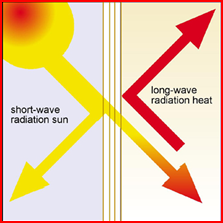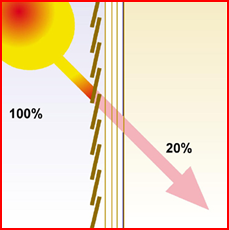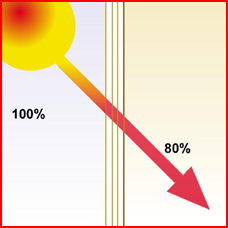The Greenhouse Affect in Your Home
It is a well-known and undisputed fact that external solar protection devices are superior to an internal system with respect to the energy transmission rate and thus to the room temperature. The fact that the greenhouse effect is responsible for this phenomenon is also generally acknowledged.
The opinion that thermal rays cannot penetrate glass to cause the greenhouse effect is only partly true. The invisible portion of the entire spectrum of solar radiation (wave lengths of approximately 800nm to 2500nm) is around 50 percent. These short-wave rays are also called near-infrared. They can penetrate normal window glass relatively easily. Once the rays have penetrated the window, they are absorbed by the surfaces in the room and then emitted again in the form of heat radiation (far-infrared in wave length range of 5000nm to 50000nm).
It is almost impossible however, for these long wave rays to penetrate the glass. They are either absorbed by the glazing or reflected back into the interior of the room. It is impossible at any rate for them to return outdoors unimpaired.

This effect is called heat trap or greenhouse effect
If the solar protection devices are then brought into play, it is important to know where they are installed. If they are installed in the front of the glazing (exterior solar protection eg. roller shutters), the rays of sunlight hit the solar protection device first, are partly absorbed (the rest either penetrate the glass or are reflected) and heat up the solar protection device. The long-wave infrared rays that are then emitted by the solar protection device, accumulate in front of the glazing and cannot penetrate it.
Heat radiation develops on the inside.
If the solar protection device is installed on the inside, it basically reacts in exactly the same way as externally installed solar protection devices, the only difference being that the heat radiation develops behind the glazing and therefore cannot escape outside. This physical affect is unavoidable, and as a result external solar protection devices can be described in simple terms as follows: the less radiation is transmitted, the more effective the solar protection device. Reflection and absorption are of a secondary importance.


Internal solar protection devices can be described as follows: the greater the radiation reflection, the more effective the protection device. Whether the rays of sunlight are absorbed by the solar protection device or transmitted and then absorbed by other surfaces is of secondary importance. In both cases heat is generated which raises the temperature of the room.

